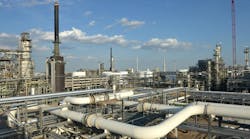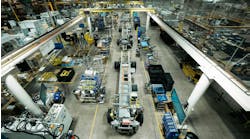Behind the scenes at the refinery: The science of making fuel
What comes to mind when you think of modern engineering? Skyscrapers? Supercomputers? How about fuel? While fuel may not be the first thing most of us picture when it comes to technology, turning crude oil into a product the world depends on every day takes some fascinating science.
As you may know, fuel is produced through a process called oil refining. In layman’s terms, refining starts with crude oil, breaks it down to its most basic parts then puts those parts back together in new ways to create fuel. Sounds easy in theory, but in practice, there’s a lot more to it. Here’s a behind-the-scenes look at the scientific engineering that goes into every gallon of Cenex fuel.
Refineries: The production center of fuel
The heart of the action takes place at refineries, large processing plants run by some of the country’s top scientists and safety professionals. A specialized lab staff inside each refinery helps oversee the entire process from start to finish by ensuring the quality of incoming crude oil, testing samples throughout production and certifying all final products for quality.
Cenex fuel comes primarily from two U.S.-based refineries owned and operated by its parent company, CHS — America’s largest farmer-owned cooperative. Together, the two refineries produce 2.5 billion gallons of refined fuel every year. It all happens through a state-of-the-art operation, one that runs 24/7, 365 days a year.
Step 1: Breaking it down
When crude oil arrives at a refinery, it already contains many of the ingredients for fuel. In order to harness these ingredients, they first need to be separated. That’s why the refining process begins by breaking down — or distilling — crude oil to its fundamental parts.
In the refining industry, the different parts of crude oil are called fractions. To distill these fractions, crude oil is heated in stages to very high temperatures. This is done because each fraction “burns off” at a different heat, allowing them to be collected one by one.
At most refineries, distillation takes place inside tall towers that each contain a stack of heated chambers. Crude oil enters the tower at the bottom, where the temperature is the hottest. While the heaviest parts of the oil remain behind, the lighter parts vaporize and rise higher up the tower.
As these vapors ascend, they enter the next chamber above, where the temperature is lower. The heaviest vapors condense into a liquid, and a tray at the bottom of the chamber collects this newly formed extract, successfully isolating the first fraction.
Meanwhile, lighter vapors rise even further up the tower, condensing again as liquids in the cooler chambers above. In this way, distillation allows each fraction of the oil to be “shaved off” one by one, isolating the building blocks that will ultimately become fuel.
Step 2: Putting it back together
But the process isn’t over yet. Before distilled fractions can become fuel, they need to undergo the next phase of refining — conversion.
Fuel requires a precise recipe, down to the microscopic level. Within each fraction, the molecules are still too heavy for the final product after distillation. To lighten them up, each fraction enters a thick-walled reactor chamber. Inside, immense heat and pressure “crack” heavy molecules into multiple lighter ones.
After conversion, the ingredients for fuel finally come together. The newly formed fuel is treated and is finally ready to leave the refinery. But even after all this, Cenex fuel still isn’t complete. In fact, some of its most important finishing touches are still to come at its next stop, the terminal.
Think of the terminal as the link between the refinery and the fuel station. It’s at the terminal that Cenex Top Tier Detergent Gasoline gets its powerful cleaning agents, engineered to help engines run cleaner and perform more efficiently. Meanwhile, Cenex Roadmaster XL and Cenex Ruby Fieldmaster premium diesel fuels are enhanced with a complete, balanced additive package, proven on the road to reduce both downtime and maintenance costs.
From additives at the terminal to brainpower at the refinery, a lot goes into making Cenex fuel. It’s an intricate process, but it’s worth every step to provide reliable, high-quality energy products for our communities. For diesel that doesn’t mess around, use this locations finder to see Cenex stations near you.



